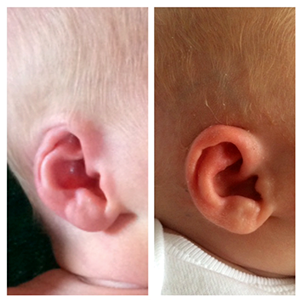What Is Ear Molding?
Ear abnormalities may lead to teasing in school, making children, and even
adults, feel self conscious. Many ear abnormalities can be corrected with
surgical procedures, but frequently these operations are denied by
insurance companies because they are considered cosmetic. Even if the child
elects to have a surgical correction, the operation usually requires that
the child be 6-7 years of age, so that the ear cartilage has developed well
enough to hold the sutures required for the operation. Additionally,
surgery can be challenging, and the best surgical results may fall short of
patient expectations. If the child is feeling self conscious about his or
her ears prior to the age of surgical correction, it can be a tough time
developmentally. If an infant is noted to have an ear shape abnormality and
is seen within three weeks of birth, many of these ear anomalies can be
corrected nonsurgically using a technique called ear molding.
Traditionally, ear molding has been difficult to employ; however, recent
advances in ear molding now make it easier to treat patients nonsurgically
and painlessly.
Improvements in the design of prefabricated systems allow plastic surgeons
to improve or correct many infant ear anomalies, including protruding ears,
helical rim anomalies, Stahl’s ear, lop ear and even cryptotia. This early
nonsurgical intervention frequently eliminates the need for surgery,
obtains an immediate correction and normalizes the ear through four to six
appointments in the plastic surgeon’s office. This early correction
prevents the child from ever having to feel as though he or she is
different from their peers.
When Should I See a Plastic Surgeon?
Studies have shown up to 53 percent of children are born with abnormalities
of the external ear, and only 30 percent of these anomalies self-correct
without treatment. Unfortunately, parents may not know if the ear
abnormality will self correct until the infant is outside of the treatment
window for ear molding. Therefore, it is recommended that infants beyond a
week of age be referred for molding therapy within the first two to three
weeks of life. It is possible to institute treatment up to 6-8 weeks of
age, but outcomes may be compromised and treatment duration will be longer.
How Does It Work?
Ear molding works by reshaping the ear during the narrow window when
circulating maternal estrogen remains at a high level in the child. If the
cartilage is molded while maternal estrogen circulates within the newborn,
it tends to retain its new shape as the maternal estrogen is metabolized.
In most cases, nonsurgical molding treatment eliminates the need for
surgery. Even if a child needs surgery when he or she is older, the surgery
likely will be less complicated than if molding had not been initiated.
Additionally, the ear will look better until surgical correction is an
option at 7-8 years of age, reducing psychosocial problems.
Risks and Complications
It is important that parents have realistic expectations to avoid
post-treatment disappointment. They are informed that molding will not
result in a perfect ear, but likely will improve the shape and form to
approximate a more normal ear shape. Risks and complications of ear molding
include skin breakdown under a positioning retractor, skin irritation from
the adhesive or failure to meet the parents’ aesthetic goals. Skin
sensitivity is rare, and any skin breakdown that may occur under a
retractor heals well by repositioning the retractor to a healthy area of
skin. Patients are seen one week after application to identify and treat
any skin breakdown or irritation. After the first week of molding, pressure
points under retractors usually subside.
Summary
Nonsurgical molding has been demonstrated to correct or improve many ear
anomalies that previously would have been corrected surgically with few
associated complications. Most insurance plans cover the procedure, so make
sure your surgeon is in network with your insurance plan to reduce
out-of-pocket costs. Because ear anomalies vary, it is recommended you see
a surgeon who is knowledgeable in both surgical and nonsurgical molding
techniques for the treatment of ear anomalies. Occasionally, molding is
used to prepare the ear for future surgical correction, and it is important
the surgeon be familiar with all aspects of ear reconstruction.


